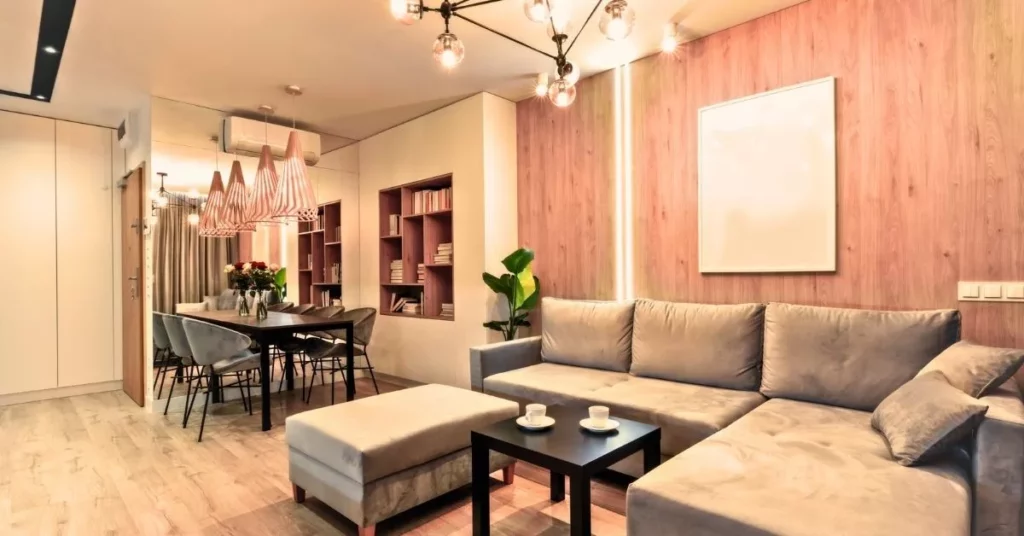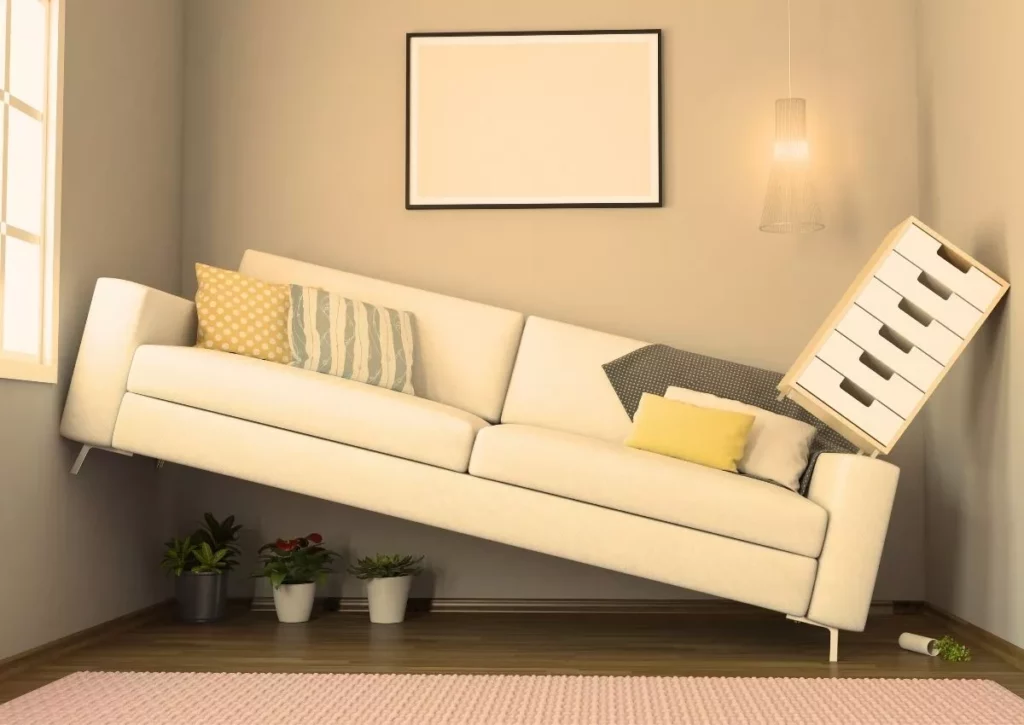
I know arranging furniture in a small living room can be tricky. But good furniture placement and smart picks can help maximize both style and function. Follow these tips to quickly create a comfy, neat, inviting small living room. Today we will share in detail how to arrange furniture in small living room.
Table of Contents
ToggleClean Up and Prepare the Space Before Arranging Furniture
Before you dive into the exciting task of arranging furniture in your small living room, it’s essential to lay the groundwork for a successful transformation. A clean and clutter-free space will not only make the process easier but also create a more pleasant and inviting atmosphere. Here are the initial steps you should take:
Start by Cleaning and Decluttering the Area
The first step in preparing your small living room for furniture rearrangement is to clean and declutter. Clear out any unnecessary items, such as old magazines, knick-knacks, and items that don’t belong in the living room. Dust and vacuum to ensure that the space is as clean as possible.
Lay Down a Rug
Once your living room is clutter-free and clean, consider adding a rug to define the area and set the stage for your furniture arrangement. Choose a rug that is large enough to accommodate all your furniture or, at the very least, a substantial portion of it. A well-chosen rug can anchor the seating area and create a sense of cohesion in the room.
By taking these preliminary steps, you’re creating a blank canvas that allows you to visualize and plan the furniture arrangement more effectively. A clean and well-prepared space is the foundation for a successful small living room transformation, making the best use of the available space and ensuring a welcoming and comfortable environment for you and your guests.
Proper Furniture Placement and Rug Size for a Spacious Feel
One of the most effective tricks in interior design is to create the illusion of more space in a small living room. Proper furniture placement and the choice of the right rug size can work wonders in this regard. Here’s how you can make your small living room appear more spacious:
Choosing a Large Rug to Expand the Space
When it comes to selecting a rug for your small living room, size matters. Opt for a rug that is large enough to encompass all or a significant portion of your furniture. This choice has a magical effect on the room’s appearance. A generously sized rug visually expands the space, creating an open and airy atmosphere. It tricks the eye into perceiving a larger area, even if the room’s dimensions are limited.
Adjusting Furniture Placement for Clear Pathways
Furniture placement is a critical aspect of making the most of a small living room. To create a spacious feel, it’s essential to arrange your furniture thoughtfully. Start by ensuring there is a clear pathway through the room. Avoid placing furniture in a way that obstructs natural traffic flow.
Consider these tips:
- Push furniture against the walls: In a small space, this can help maximize the usable area in the center of the room, making it appear more open.
- Use multipurpose furniture: Opt for furniture pieces that serve multiple functions, like storage ottomans or nesting tables, to reduce clutter and create a streamlined look.
- Keep it low-profile: Choose furniture with low profiles, as this can give the illusion of higher ceilings and more floor space.
By arranging your furniture to create clear pathways and selecting a well-proportioned rug, you can transform your small living room into a cozy and inviting space that appears larger than it actually is. These clever design choices not only enhance the look but also improve the functionality of your living area, making it a more enjoyable place to spend time.

Create a Focal Point in the Room
Don’t forget, in your small living room, create a focal point for a more appealing space. It’s a crucial design strategy. A focal point not only adds visual interest but also draws attention away from the room’s size limitations. Here’s how to go about it:
Choose a Focal Point
Identify a natural focal point in your small living room. This could be a feature like a fireplace, a large window with a scenic view, a piece of art, or even a television. The focal point should be the element that you want to highlight and design the rest of the room around.
Place the Furniture in a ‘U’ Shape for Conversation and TV Viewing
Once you’ve selected your focal point, arrange your furniture in a ‘U’ shape. This layout not only encourages conversation but also optimizes the viewing experience, especially if your focal point is a TV. Here’s how to do it:
Position your sofa in the center, facing the focal point. This can be the television or any other feature you’ve chosen.
Place two additional seating options, like armchairs or smaller sofas, on either side of the sofa, creating a ‘U’ shape. This arrangement promotes easy interaction among guests while providing a clear line of sight to the focal point.
If space allows, you can even add a cozy reading nook in one corner, with a comfortable chair and a small bookshelf.
Consider Adding a Coffee Table and a Small Table Between Chairs for Convenience
Adding a coffee table in front of the sofa can improve function. Also put a small table between chairs for convenience. The tables give a spot for drinks, snacks, and decor. They offer surfaces to set items down. Including these tables also makes the overall room look more aesthetically pleasing.
Additional Tips for Small Living Room Furniture Arrangement
Ensure Adequate Space for Movement: To create a comfortable living environment, ensure that there are at least 12 inches of space between furniture pieces. This not only allows for ease of movement but also prevents the room from feeling cramped.
Organize Remote Controls: Consider adding a dedicated spot for remote controls. A small, stylish tray, a remote control holder, or a side table with built-in storage can help keep remotes in one place, reducing clutter and making them easy to find.
Minimal Centerpieces: When decorating your coffee table or any other surface, keep centerpieces minimal to avoid obstructing views or taking up valuable surface space. Opt for smaller, versatile decor items like a vase of flowers, a couple of decorative books, or a tray with a few carefully chosen items. This maintains an open, airy feel in your small living room.

5 Tips for Decorating a Small Area with Furniture Placement
1.Use Multi-Functional Furniture: In a small area, space-saving furniture is your best friend. Look for pieces that serve dual purposes, like a sofa bed, a coffee table with storage, or a dining table that can be folded down when not in use. This maximizes both functionality and space.
2. Wall-Mounted Shelves: Consider installing wall-mounted shelves to free up floor space. These shelves can hold decorative items, books, or even act as a mini-library. This not only adds functionality but also offers an opportunity for creative decor placement.
3. Mirrors for Illusion: Mirrors can visually expand a small area by reflecting light and making it feel more spacious. Consider incorporating a large mirror on one wall or smaller decorative mirrors to bounce light and create a sense of openness.
4. Vertical Decor: When arranging furniture, think vertically. Utilize the vertical space with tall bookshelves, floor-to-ceiling curtains, or hanging plants. This draws the eye upward and gives the illusion of higher ceilings, making the room appear larger.
5. Keep It Cohesive: Choose a consistent color palette and style for your decor. This creates a sense of cohesion, making the space feel more harmonious and less cluttered. Avoid too many contrasting colors or overly busy patterns that can make a small area feel chaotic.
By implementing these additional tips, you’ll be able to make the most of your small space, creating an inviting and visually appealing environment.
5 Tips For Furniture Placement Should Avoid Overcrowding and Ensure Proper Alignment.
1. Create Clear Pathways: Ensure that you maintain clear pathways throughout the room. Avoid placing furniture in a way that obstructs the natural flow of movement. People should be able to move around the room comfortably without having to navigate around furniture.
2. Group Furniture Thoughtfully: Group furniture pieces according to their function. For example, place seating together in conversation areas and the dining table and chairs together in a dining zone. This creates a sense of order and purpose in each section of the room.
3. Avoid Furniture Overcrowding: Avoid crowding too many pieces of furniture into a small space. Less can often be more in a compact room. Select your furniture pieces carefully, ensuring that they fit the scale of the room without making it feel cramped.
4. Balance Furniture Placement: Achieve balance in your furniture placement by distributing the visual weight evenly. For example, if you have a large, heavy sofa on one side of the room, balance it with a substantial piece of furniture or decor on the opposite side. This helps create symmetry and a harmonious look.
5. Artwork Placement: Consider the placement of artwork in relation to your furniture arrangement. Art should complement and enhance the overall design. Hang artwork at eye level and ensure that it is appropriately sized for the wall it’s on, avoiding pieces that overpower or get lost within the room.
By following these additional tips, you’ll be able to arrange your furniture in a way that maintains a sense of spaciousness, avoids overcrowding, and ensures proper alignment for a well-balanced and visually appealing living space.

